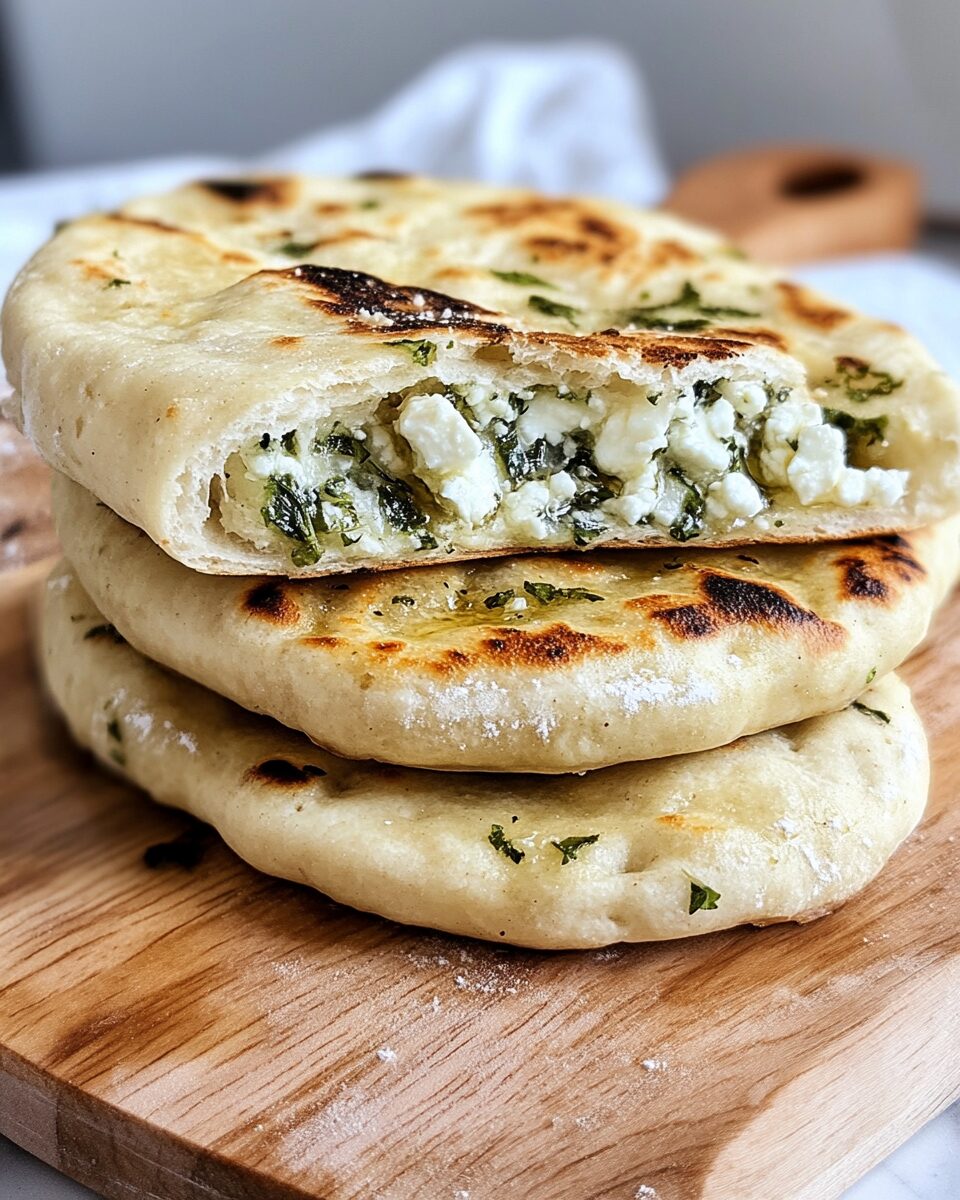The delicate crunch of these flatbreads, paired with the creamy saltiness of feta and the freshness of spring herbs, creates a delightful balance in every bite. The light lemon zest adds a refreshing brightness that elevates the earthy spinach and parsley, making the flatbreads irresistibly flavorful and aromatic.
These flatbreads are wonderfully versatile — perfect as a standalone snack, a side for salads, or a base for creative toppings. Their simplicity and fresh ingredients celebrate Mediterranean flavors with ease and elegance, making them an excellent choice for casual gatherings or a quick, wholesome bite.
Full Recipe:
-
250g self-raising flour
-
200g feta cheese
-
50g fresh spinach
-
50g fresh parsley
-
1 lemon, zest only
-
100ml water
-
2 tbsp olive oil
-
Salt and pepper to taste
Directions:
-
Combine flour, crumbled feta, chopped spinach, parsley, and lemon zest in a bowl.
-
Gradually add water and olive oil, mixing to form a dough.
-
Knead lightly, divide dough into portions, roll into thin flatbreads.
-
Cook flatbreads in a hot, lightly oiled frying pan for 2-3 minutes each side until golden and crisp.
-
Serve warm with a drizzle of olive oil or your favorite dip.
Prep Time: 10 minutes | Cooking Time: 15 minutes | Total Time: 25 minutes
Kcal: Approximately 280 kcal per serving | Servings: 4
The Cultural Roots and Background of Feta Spring Flatbreads
Flatbreads have been an essential component of human diets for thousands of years, tracing back to ancient civilizations across the Mediterranean, Middle East, and beyond. Their simple composition—mainly flour and water—allowed early cultures to develop versatile breads that could be cooked quickly and paired with a variety of flavors. Feta Spring Flatbreads are a modern interpretation rooted deeply in Mediterranean culinary traditions, particularly Greek cuisine. The use of feta cheese, a beloved Greek staple, combined with fresh herbs and greens, evokes the freshness and vibrancy of springtime in the region.
In Greece, bread is more than sustenance; it’s a symbol of hospitality, community, and tradition. Sharing bread at the table is a cultural ritual that brings people together. This recipe pays homage to those roots by incorporating flavors that are both authentic and seasonally inspired. The herbs—parsley and spinach—are abundant in the spring, representing renewal and freshness, while the feta offers the salty tang that balances and enhances the herbs’ natural vibrancy.
Why Feta Spring Flatbreads Stand Out: Flavor and Texture
What makes Feta Spring Flatbreads truly special is their unique balance of textures and flavors. The crispy exterior, golden from frying in olive oil, contrasts beautifully with the soft, flavorful interior studded with crumbled feta and fresh greens. The salty, creamy feta melts slightly as it cooks, infusing the flatbread with a rich depth that harmonizes perfectly with the fresh, herbaceous notes from parsley and spinach.
Lemon zest plays a subtle but vital role by introducing a bright, citrusy aroma that elevates the overall flavor profile, preventing the dish from becoming too heavy or one-dimensional. The fresh herbs add a mild bitterness and an earthy freshness that brighten each bite, while the olive oil brings a fruity, peppery richness and helps achieve that desirable crispness on the outside.
Together, these elements create a balanced and satisfying dish that appeals to the senses and offers a taste experience deeply rooted in Mediterranean cooking.
Seasonal Appeal and Nutritional Benefits
Spring is a season that invites lighter, fresher meals after the heaviness of winter. The ingredients in this flatbread recipe mirror that transition perfectly. Using seasonal greens such as spinach and parsley ensures not only maximum freshness and flavor but also nutritional density. Spinach is rich in iron, vitamins A and C, and antioxidants, supporting immune function and overall vitality. Parsley adds vitamin K and C, along with flavonoids that have anti-inflammatory properties.
Feta cheese contributes protein and calcium, important for bone health, while olive oil offers heart-healthy monounsaturated fats and antioxidants that support cardiovascular wellbeing. This combination makes Feta Spring Flatbreads a balanced dish that offers sustenance without heaviness, ideal for spring and beyond.
Versatility and Serving Ideas
One of the most appealing aspects of these flatbreads is their versatility. They can be served in numerous ways to suit different occasions, meals, or personal preferences. Enjoy them fresh and warm as a simple snack, brushed lightly with extra virgin olive oil and perhaps a sprinkle of flaky sea salt.
For a light lunch or appetizer, pair them with traditional Mediterranean sides such as Greek salad, olives, hummus, or tzatziki. The flatbreads also work wonderfully as a base for more substantial toppings—think roasted vegetables, grilled chicken, or even a dollop of creamy labneh for added richness.
At casual gatherings or picnics, these flatbreads can be cut into bite-sized pieces and served as part of a mezze platter alongside an array of dips, nuts, and fresh vegetables. Their crispy texture and fresh flavors add a delightful contrast to creamy and savory accompaniments.
Tips and Techniques for the Perfect Flatbread
Achieving the ideal texture and flavor in these flatbreads is about balance and attention to detail. The dough should be handled gently—over-kneading can lead to a tough texture rather than a tender crumb. The right hydration level is key; too dry and the dough cracks, too wet and it becomes difficult to roll out.
Cooking on a hot skillet with sufficient olive oil creates a golden, crisp crust that enhances both texture and flavor. The flatbreads should be thin enough to cook quickly yet thick enough to hold the fillings and remain tender inside. Using freshly grated lemon zest, rather than bottled lemon flavoring, will make a significant difference in the bright, fresh aroma.
Lastly, serving the flatbreads warm ensures the feta retains its creamy quality and the herbs remain vibrant. If made ahead, reheat gently in a pan or oven rather than the microwave to maintain crispness.
Possible Variations to Explore
This recipe lends itself beautifully to experimentation. Swap spinach for other leafy greens such as kale or arugula to introduce different flavor nuances—kale adds a heartier earthiness, while arugula brings a peppery bite.
Incorporating other herbs like dill, mint, or chives can provide new aromatic layers. Adding sun-dried tomatoes or olives will introduce bursts of tang and saltiness, elevating the Mediterranean character of the dish.
For those seeking vegan options, replace feta with plant-based cheese alternatives or seasoned tofu crumbles. Another creative approach is turning the flatbreads into mini pizzas by topping them with tomato sauce, mozzarella (or vegan cheese), and fresh basil before a quick bake.
Cultural Significance and Mediterranean Connection
The Mediterranean diet is celebrated worldwide for its flavor, balance, and health benefits, and flatbreads are an iconic part of this culinary tradition. These breads serve as an edible foundation to a meal, often shared among family and friends, symbolizing togetherness.
Feta Spring Flatbreads capture the essence of this cultural heritage by highlighting fresh, local ingredients and simple preparation methods that have been passed down through generations. This dish bridges past and present, blending traditional flavors with modern convenience and culinary creativity.
Health and Wellness Considerations
Beyond flavor and cultural significance, this recipe aligns well with contemporary health-conscious eating. The Mediterranean diet, rich in vegetables, healthy fats, and moderate dairy, has been linked to reduced risk of chronic diseases including heart disease, diabetes, and certain cancers.
The combination of fresh greens and herbs supports digestion and provides antioxidants that combat inflammation. The moderate use of cheese offers calcium and protein without excess saturated fat. Olive oil, a cornerstone of Mediterranean cooking, contributes to healthy cholesterol levels and overall cardiovascular health.
For those mindful of calories or dietary restrictions, these flatbreads can easily be modified to be gluten-free by using alternative flours, or dairy-free by selecting vegan cheese options, making them accessible and inclusive.
Ideal Occasions and Pairings
This dish is suitable for a variety of occasions, from casual weekday meals to festive gatherings. Their quick preparation makes them perfect for busy weeknights when a nourishing meal is needed without fuss. On weekends or special occasions, their vibrant flavors and rustic charm make them a crowd-pleaser for sharing.
Pairing with a fresh Greek salad, roasted lemon potatoes, or grilled seafood can create a complete Mediterranean-inspired meal. For brunch, serve alongside poached eggs and fresh tomatoes. They can also act as a delightful starter or side dish at dinner parties, complementing robust main courses with their light, fresh flavor profile.
Conclusion
Feta Spring Flatbreads are a delightful celebration of Mediterranean simplicity and freshness. With their crisp texture, vibrant herbs, and savory feta, they bring a burst of flavor and nutrition to any table. Their adaptability allows cooks of all skill levels to customize the recipe to their tastes or dietary needs, making them a versatile favorite year-round.
By connecting traditional ingredients with quick, easy preparation, these flatbreads invite everyone to experience the joy of Mediterranean cooking. Whether enjoyed as a snack, appetizer, or part of a larger meal, they embody wholesome eating, vibrant flavors, and a shared cultural heritage that enriches the dining experience.





